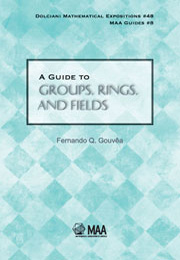4 - Groups and their Representations
Summary
At first, groups were groups of transformations. In the theory of equations, they appeared permuting the roots of polynomials and permuting the variables in rational functions. A few decades after, groups of geometric transformations were discovered and studied. It was only much later that the abstract notion of a group was introduced.
A modern approach must start from the abstract notion. But history reminds us to introduce group actions early in the game and to study groups via their actions. This is how we present the theory here.
DEFINITIONS
The crucial definitions specify the objects, the acceptable functions, and what an action is. As always, once we have a clear notion of the objects we are studying, we also want to consider sub-objects.
GROUPS AND HOMOMORPHISMS
Definition 4.1.1A group is a set G together with an operation (usually called “multiplication” and denoted by juxtaposition) such that:
1. (ab)c = a(bc) for all a, b, c ∈ G,
2. there exists an element 1 ∈ G such that we have a1 = 1a = a for all a ∈ G, and
3. given a ∈ G there exists a–1 ∈ G such that aa–1 = a–1a = 1.
A group in which we have, in addition, that ab = ba for all a, b ∈ G is called a commutative group or an abelian group.
Definition 4.1.2Let G1 and G2 be groups. A function f : G1 → G2 is called a homomorphism (or, if necessary, a group homomorphism) if for all a, b ∈ G1we have f(ab) = f(a)f(b).
- Type
- Chapter
- Information
- A Guide to Groups, Rings, and Fields , pp. 29 - 106Publisher: Mathematical Association of AmericaPrint publication year: 2012



